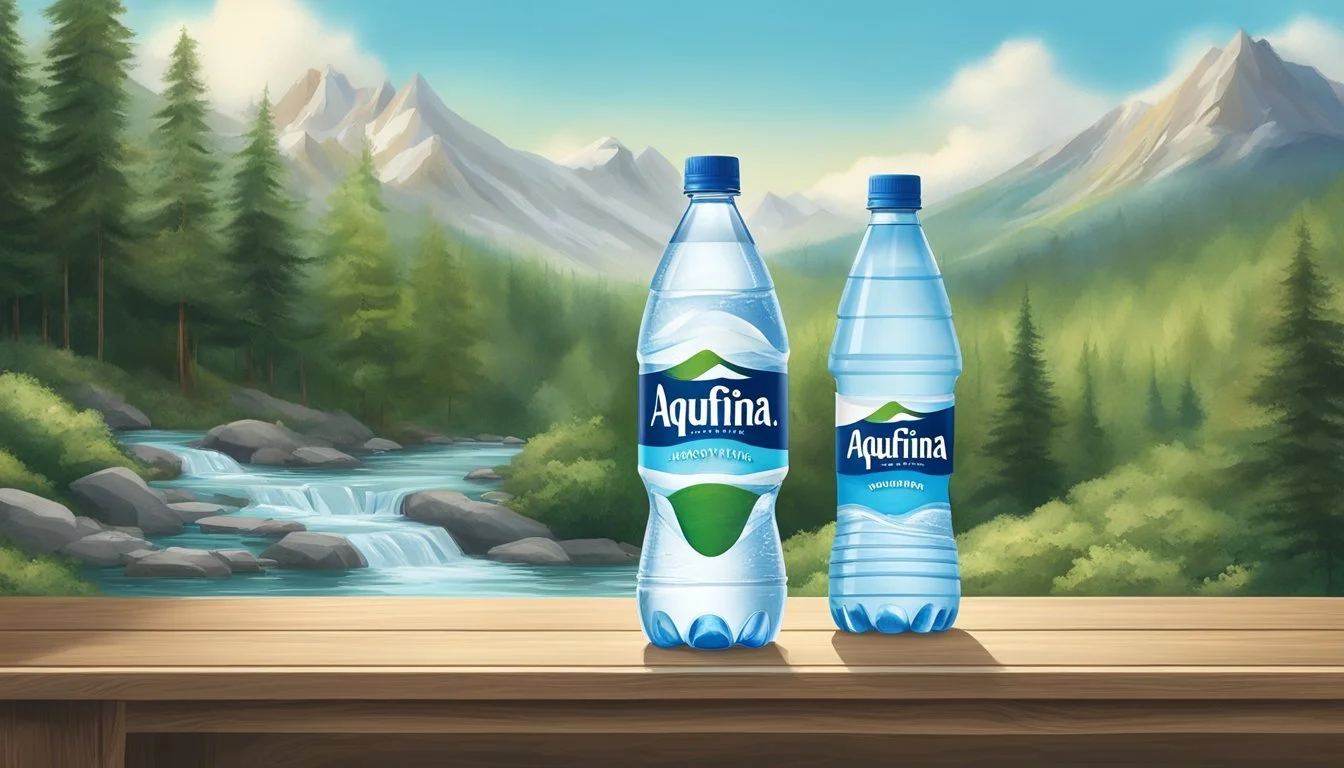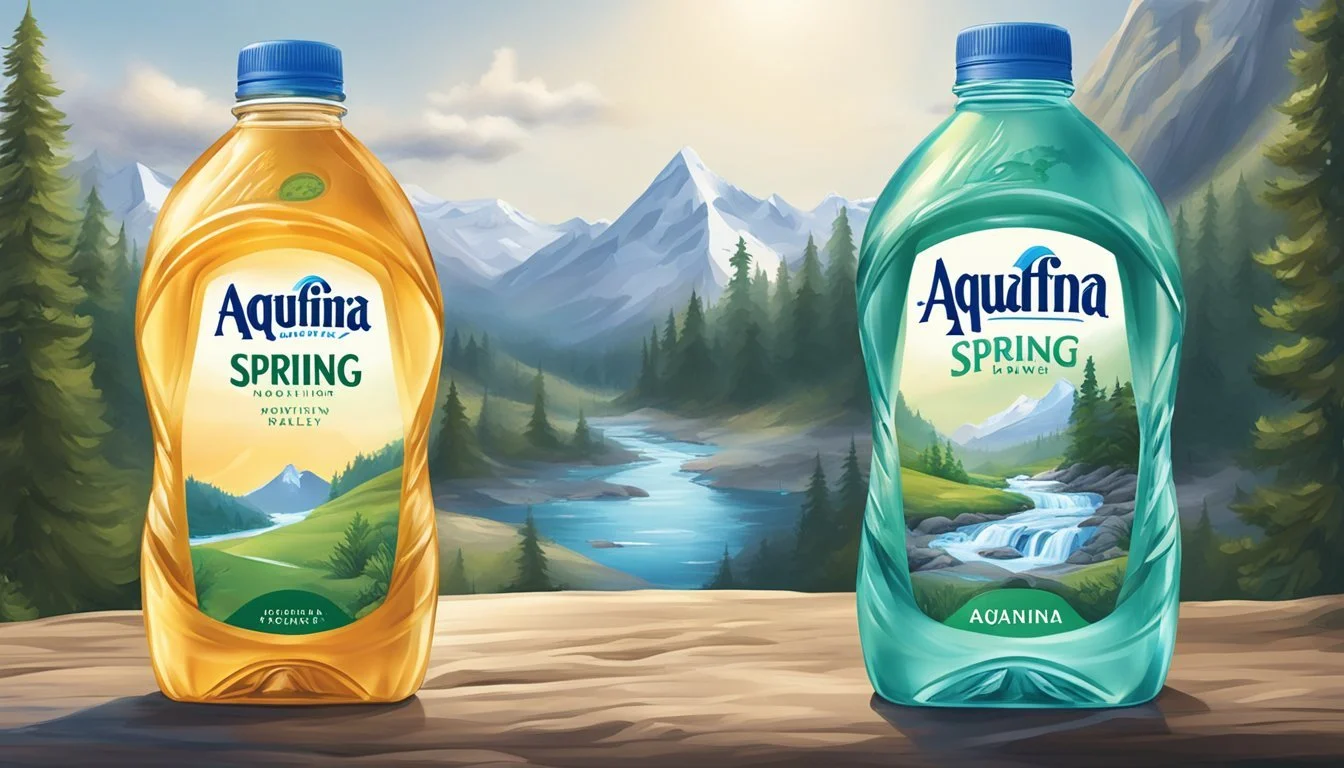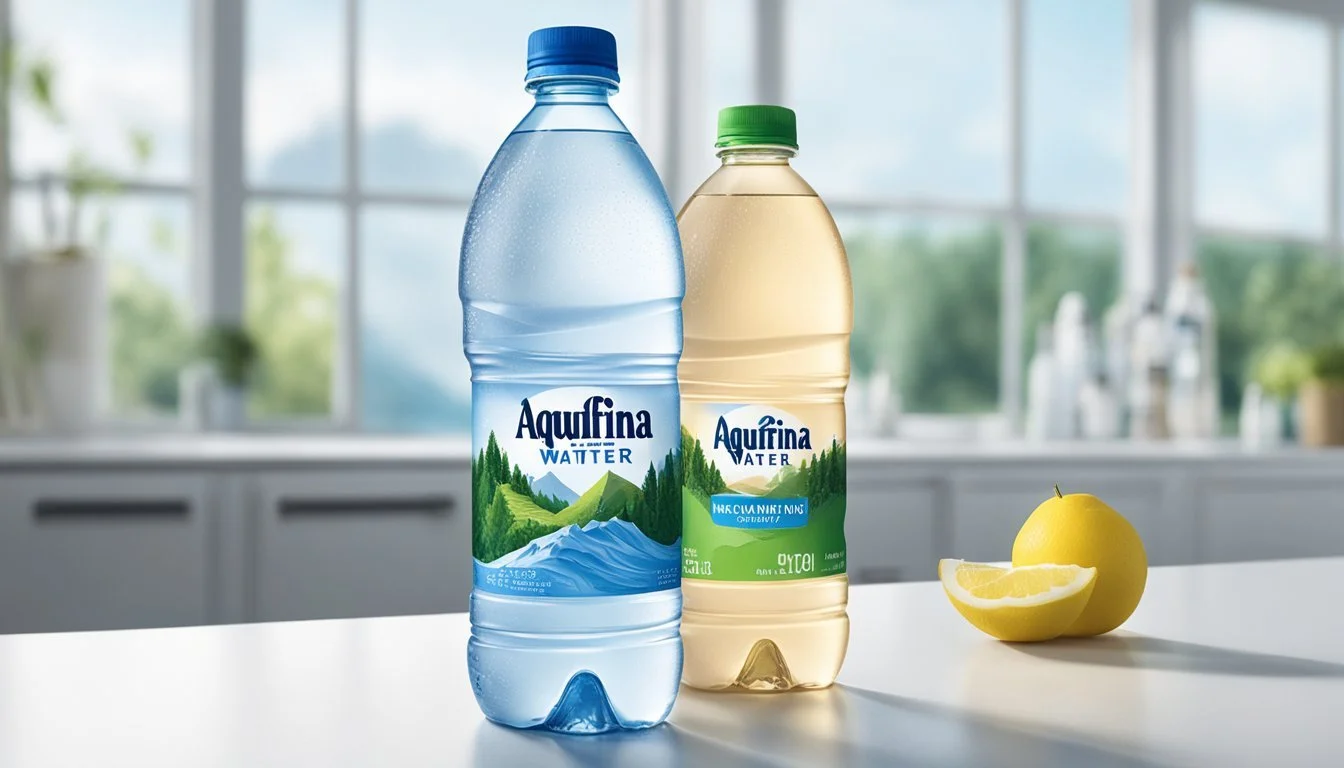Aquafina vs. Mountain Valley Spring Water
Unveiling the Superior Hydration Choice
Selecting the right bottled water can be more complex than it initially appears. On one hand, Aquafina, a purified drinking water, is processed by PepsiCo, which employs a thorough purification system that includes reverse osmosis, ultraviolet, and ozone sterilization. This process is designed to deliver consistent taste and purity, making it widely available and a popular choice for consumers seeking clean and safe drinking water.
Conversely, Mountain Valley Spring Water offers a completely different experience. Sourced from a spring in the Ouachita Mountains, this brand prides itself on its natural composition and mineral content, which are inherent to its spring source. Marketed as a premium water option, Mountain Valley Spring Water appeals to those who prefer natural mineral water with minimal processing, believing it to maintain the water's original quality and healthful benefits.
Both brands have carved out their own distinct reputations within the bottled water market. Aquafina's focus on purification and availability contrasts with Mountain Valley's emphasis on natural source and mineral content. Consumers make their choice depending on factors such as taste preference, perceived health benefits, and the intended use of the water, be it for daily hydration or for culinary purposes.
Analyzing Bottled Water
When consumers choose bottled water, they are often influenced by the source and purity of the water. Two prominent brands are Aquafina and Mountain Valley Spring Water, each with unique characteristics.
Aquafina is a brand known for its purification process, which includes reverse osmosis. This brand filters municipal water with the aim to remove substances. As a result, Aquafina offers consumers consistent taste and purity levels.
Mountain Valley Spring Water, in contrast, is sourced from natural springs in Arkansas. This brand prides itself on providing natural mineral water with a distinct composition from the spring's ecosystem.
Quality Comparison:
Source: Aquafina uses public water sources; Mountain Valley is spring-sourced.
Treatment: Aquafina undergoes reverse osmosis; Mountain Valley is minimally treated to preserve minerals.
Labeling Transparency:
Aquafina: Label discloses purification process.
Mountain Valley: Label highlights spring source and natural mineral content.
Consumers may also consider environmental impact. Bottled water brands differ in their use of materials and recycling initiatives. Therefore, assessing each brand's environmental policies can be integral to the decision-making process.
Considering health and taste, the presence of minerals in Mountain Valley may offer a different flavor profile compared to the more neutral taste of Aquafina. These factors make each brand appealing to different consumer preferences related to health, taste, and the environment.
Understanding Water Sources
When choosing bottled water, the source of the water is a crucial factor to consider. This section examines the origins of Aquafina and Mountain Valley Spring Water, compares spring and purified water types, and highlights the geologic significance of regions like the Ouachita Mountains that contribute to water quality.
Revealing the Origin
Aquafina is sourced from municipal tap water before undergoing a rigorous purification process. In contrast, Mountain Valley Spring Water comes directly from natural springs, specifically in the Ouachita Mountains. Both sources serve different consumer preferences, with Aquafina focusing on purity and Mountain Valley on natural minerality.
Spring Water Vs. Purified Water
Spring Water: Derived from underground formations where water naturally flows to the surface (e.g., Mountain Valley Spring Water, Poland Spring).
Purified Water: Tap or groundwater that has been purified to remove chemicals and pathogens (Aquafina, Dasani).
Essentia and Core Hydration use purified water, often enhanced with added minerals for taste and marketed benefits.
Significance of the Ouachita Mountains
The Ouachita Mountains are a unique geological feature that provides a natural filtration system. Waters like Mountain Valley Spring Water traverse through layers of rock, acquiring minerals and a distinctive taste. This pristine region is highly regarded for producing some of the finest natural spring waters.
The Role of Volcanic Rock
Volcanic rock, such as that found around the Mauna Loa Volcano, has a porous nature that aids in filtering water to produce a crisp taste. Brands like Fiji Water and Icelandic Glacial promote the natural filtration benefits of volcanic rock in their marketing to signify purity and a unique mineral profile.
Health Implications
The health implications of bottled water from Aquafina and Mountain Valley Spring Water can be influenced by factors such as the presence of minerals and electrolytes, pH levels, potential contaminants, and their overall contribution to hydration and health.
Effects of Minerals and Electrolytes
Mountain Valley Spring Water is known for its naturally occurring minerals and electrolytes, which include calcium and magnesium. These elements are essential for bodily functions and can contribute to the electrolyte balance needed for hydration. Conversely, Aquafina, produced by Coca-Cola, is purified water and has most minerals and electrolytes removed in the purification process. Some consumers might prefer the added minerals for taste and health benefits.
Assessing pH Levels and Alkalinity
The pH level of Mountain Valley Spring Water tends toward alkaline, commonly boasting a pH above 7. Alkaline water has been claimed by some to offer health benefits, although these claims are not universally accepted by the scientific community. On the other hand, Aquafina is known to have a pH level close to neutral 7, which suits those who prefer water that closely mimics the natural pH level of the human body.
Considering Contaminants and Heavy Metals
Ensuring clean drinking water involves testing for contaminants and heavy metals such as lead, arsenic, and total dissolved solids. Both Aquafina and Mountain Valley Spring Water are subject to rigorous testing. Aquafina is treated through reverse osmosis to remove contaminants, while Mountain Valley Spring Water is naturally protected but still monitored for quality. Reports have identified PFAS chemicals in some bottled water brands, but there is no specific public data implicating either Aquafina or Mountain Valley Spring Water with such contamination.
Hydration and Health Benefits
Both brands effectively provide hydration, a fundamental health benefit of any drinking water. While Aquafina offers pure, unadulterated hydration, Mountain Valley Spring Water's natural blend of minerals may offer additional health benefits as they are part of the recommended daily intake of essential minerals. Consumers should choose based on their hydration needs and preference for mineral content.
Environmental and Sustainability Concerns
In the comparison of Aquafina and Mountain Valley Spring Water, it is crucial to consider the environmental impact and sustainability practices of the bottled water industry.
Industry Impact on Environment
Aquafina, owned by PepsiCo, and Mountain Valley Spring Water, famed for its use of reusable glass bottles, represent two significant but distinct approaches within the bottled water market. The industry itself has been scrutinized for its environmental footprint, particularly in areas such as resource consumption, waste generation, and recycling challenges.
Resource Consumption: The production of bottled water, including brands like Aquafina, Deer Park, and San Pellegrino, requires substantial amounts of water and energy, sometimes exerting pressure on local water resources. The impact goes beyond just water extraction, encompassing the entire life cycle from manufacturing to transportation.
Waste and Recycling: Plastic bottles, used by Aquafina and many other companies like La Croix and Arrowhead, are often scrutinized for their environmental impact due to the presence of BPA and the challenges associated with recycling. Although some brands have shifted towards BPA-free plastics, the issue of non-recyclable waste persists. In contrast, Mountain Valley Spring Water opts for glass bottles, which are recyclable and can be reused multiple times, helping to lower the brand's environmental footprint.
Sustainability Initiatives: Sustainable practices are increasingly important for bottled water brands. The International Bottled Water Association (IBWA) often advocates for environmentally responsible actions, encouraging companies to shift toward more sustainable options like boxed water or eco-friendly packaging materials. Brands like Aquafina have taken steps to reduce their carbon footprint and implement water stewardship programs.
The environmental and sustainability concerns surrounding the bottled water industry continue to prompt both consumers and companies to focus on more environmentally friendly practices. It remains clear that the choice between different bottled water brands can significantly influence the environmental impact of one's consumption.
Brand Profiles and Comparisons
In the crowded market of bottled water, each brand stands out with its unique selling points and water source. This section delves into two popular brands, Aquafina and Mountain Valley Spring Water, exploring their market presence and what sets them apart.
Top Bottled Water Brands Analysis
Evian: Originating from the French Alps, Evian's water is globally recognized for its mineral content and taste. It holds a strong market presence alongside other premium brands like Perrier, which is known for its naturally carbonated mineral water from France. SmartWater is also a major player, offering electrolyte-enhanced water that caters to health-conscious consumers.
Poland Spring: This brand sources its natural spring water from Maine, USA. It’s frequently juxtaposed with Nestlé Pure Life, which often comes from various sources and includes purified municipal water. Zephyrhills is akin to Poland Spring in that it's sourced from springs in Florida, USA, while Arrowhead Mountain Spring Water is tapped directly from mountain springs in California, USA.
LIFEWTR brands itself as a premium water source, providing purified water that is pH balanced with added electrolytes for taste.
Aquafina and Mountain Valley Spring Water, although both popular, aim at different market segments with Aquafina being more widely available and Mountain Valley appealing to those seeking water from a natural spring source in the US.
Aquafina Versus Mountain Valley Characteristics
Aquafina:
Source: Public water sources (municipal supplies).
Purification: Seven-step Hydro-7™ purification system, which includes reverse osmosis and other filtering methods.
Market Position: Widely available, marketed as pure and perfect for everyday hydration.
Packaging: Plastic bottles in various sizes for convenience.
Mountain Valley Spring Water:
Source: A single spring in the Ouachita Mountains of Arkansas, USA.
Purification: Naturally filtered; no need for intensive purification due to the protected spring source.
Mineral Content: Naturally mineral-rich, providing a distinct taste.
Market Position: Positioned as a premium brand, appealing to natural and health-conscious consumers.
Packaging: Glass and plastic bottles to maintain the water’s quality and cater to different consumer preferences.
Each brand's sourcing and purification process makes them unique: Aquafina's rigorous purification suits those who prefer consistently pure water from a recognizable brand, while Mountain Valley's natural spring source attracts those who value minerals and an untouched source.
Consumer Considerations
When choosing between Aquafina and Mountain Valley Spring Water, consumers weigh various factors such as taste preferences, water types, and the convenience of purchasing. These considerations can significantly influence their purchasing decision.
Taste Preferences
Consumers often have distinct taste preferences that play a crucial role in their choice of bottled water. Aquafina, being a purified water brand, has a clean and crisp taste due to its extensive filtration process. It contains little to no minerals, which can be appealing to those who prefer a neutral flavor. Mountain Valley Spring Water, on the other hand, is a natural spring water, known for its distinctive taste that includes a unique mineral balance derived from its source. Individuals may prefer this earthier taste that reflects the water’s natural origin.
Choosing Water Based on Types
The type of water is a significant factor for consumers. Aquafina is known for its reverse osmosis purification method, which removes most contaminants and minerals, classifying it as purified water. Mountain Valley Spring Water is categorized as spring water, sourced from a natural spring, and contains naturally occurring minerals. Consumers looking for the health benefits of minerals may lean towards spring water, while those wanting purity might opt for brands like Aquafina. Additionally, some consumers might compare these brands against others like Fiji Water, which also offers a unique mineral profile and artesian source.
Convenience and Access
Convenience affects consumer choice, particularly in terms of accessibility and availability. Aquafina, being one of the most widespread brands owned by PepsiCo, is readily available in most grocery stores, vending machines, and convenience stores, thus catering to consumers seeking easy-to-find hydration options. Mountain Valley Spring Water is also available in many stores but might be less ubiquitous than Aquafina. For consumers who prioritize convenience, the ease with which they can purchase their preferred water at their local grocery store is a deciding factor.
By taking into account these specific considerations, consumers can make an informed decision that aligns with their preferences and needs.
Expert Opinions and Research
This section examines the findings of health professionals, scrutinizes the available scientific data, and considers the implications of investigative journalism on the topic of Aquafina vs. Mountain Valley Spring Water.
Recommendations by Health Experts
Health experts tend to emphasize the importance of water purity and the source of bottled water when making recommendations. Aquafina, a PepsiCo product, is purified municipal water that goes through a 7-step purification process, including reverse osmosis. Mountain Valley Spring Water, on the other hand, is lauded for its natural spring source, which is rich in minerals. Experts suggest that while both are safe, the natural minerals in Mountain Valley may offer additional health benefits.
Scientific Studies and Evidence
Scientific studies have focused on the safety and composition of bottled water. The Environmental Protection Agency (EPA) sets standards for tap water, while the Food and Drug Administration (FDA) regulates bottled water. Both Aquafina and Mountain Valley meet and exceed these regulatory standards. Research has not shown significant health differences between purified and spring waters; however, some studies suggest natural spring water may have beneficial mineral compositions.
Investigative Reports
Investigative journalists play a crucial role in uncovering corporate malfeasance and ensuring the safety of consumer products. Ryan Felton, an investigative journalist, has highlighted via email exchanges and articles on Twitter and other platforms the importance of transparency in the bottled water industry. Through investigative reports, the sourcing and marketing practices of bottled water companies have come under scrutiny, but no major concerns regarding Aquafina or Mountain Valley have been highlighted recently. Consumers often look to journalists like Felton, who publish their findings and are available for further discussion through email or direct messaging platforms like Signal, for reassurances about their choices in bottled water.
Final Assessment
In comparing Aquafina and Mountain Valley Spring Water, consumers should consider quality, taste, and source of the water.
Bottom Line on Water Choice
When assessing bottled water brands like Aquafina and Mountain Valley, experts tend to focus on factors such as the source of the water, the purification process, and presence of contaminants or additives. Aquafina, which is a PepsiCo product, is known for its rigorous purification process, including reverse osmosis. They claim this process results in pure water, consistent in taste and quality.
In contrast, Mountain Valley Spring Water prides itself on its natural source, hailing from a spring in Arkansas. It boasts a unique mineral composition that many believe contributes to its taste and potential health benefits. Unlike Aquafina, which is demineralized, Mountain Valley retains these minerals, providing a different profile of taste and texture.
The bottom line regarding water choice between Aquafina and Mountain Valley Spring Water depends on personal preference and values. If purity achieved through extensive filtration is a top priority, Aquafina may be the preferred choice. For consumers who favor natural spring water with its innate minerals and are looking for a taste that reflects its natural source, Mountain Valley Spring Water should be considered.
Additional Resources
For those looking to expand their understanding of bottled water options, particularly Aquafina and Mountain Valley Spring Water, the Additional Resources section provides a curated selection of references and contact avenues. Readers can access further scientific studies and reports or reach out to the respective companies for detailed product information.
Further Reading and Studies
Aquafina: The quality and sourcing information for Aquafina can be found in various studies and reports available in PDF format from PepsiCo's website.
Mountain Valley Spring Water: Independent research and comparative studies about Mountain Valley Spring Water are accessible in academic journals and the company's official resources section.
Contact Information
Aquafina (PepsiCo) Contact:
Twitter: @PepsiCo
Mountain Valley Spring Water Contact:
Signal: Mountain Valley Spring Water does not explicitly list Signal for contact but can be reached through the provided email or phone number for direct inquiries.
About the Author
The author of this article is a well-regarded food and beverage analyst with a specialization in the bottled water industry. With over a decade of experience, she has developed a keen sense for the nuances that distinguish various bottled water brands.
Her qualifications include:
A Master’s degree in Nutrition Science
Certification from the Beverage Institute for Health & Wellness
Regular attendance at international beverage conferences
Publications and Contributions: She has contributed to numerous food and health publications, providing insights into the quality, sourcing, and environmental impact of bottled water. Her work emphasizes the importance of understanding water purity, mineral content, and the overall taste profile that each brand offers.
Expertise Areas:
Water Purification Processes: Exploring the methods used to achieve purity in bottled water.
Mineral Content Analysis: Understanding how different mineral compositions can affect both the taste and health benefits of water.
Environmental Impact: Assessing the ecological footprint of bottled water production and packaging.
Her analysis is based on a combination of scientific research, direct product comparisons, and industry trends, ensuring that readers receive a well-rounded perspective. In this article, she examines Aquafina and Mountain Valley Spring Water, providing an informed comparison to help consumers make educated choices.









